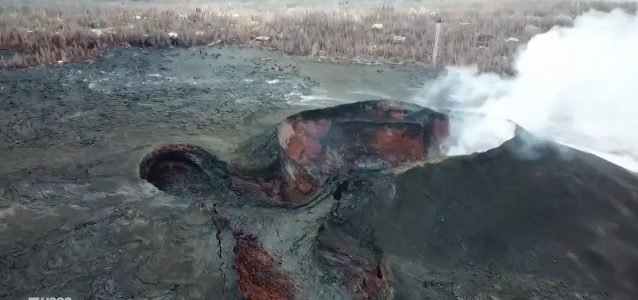Last week, a drone flying of Hawaii’s Kilauea eruption notices a change in its Lower East Rift Zone (LERZ), fissure 8. USGS scientists flying over fissure 8 noticed that the jets were throwing spatter — fragments of glassy lava — from small incandescent areas deep within the cone. Scientists note that this activity is an indication that the eruption may be paused rather than pau (over). The Unmanned Aircraft Systems (UAS) team assessed conditions at the fissure 8 cone and upper lava channel on August 17, 2018.
At the time of the flight, the lava pond within the cone had crusted over with no observed incandescence.
The reddish-brown rock inside the cone is the result of oxidation; the interaction of heated rock and gases causes black basaltic cinders to change color, similar to rust forming on metal.
Kilauea Volcano has remained quiet with no collapse events at the summit since August 2. Except for a small, crusted-over pond of lava deep inside the fissure 8 cone and a few scattered ocean entries, lava ceased flowing in the LERZ channel on August 6.
Sulfur dioxide (SO2) emissions rates at the summit and LERZ are also drastically reduced. The combined rate is lower than at any time since late 2007.
It remains too soon to tell if this diminished activity represents a temporary lull or the end of the LERZ lava flows and/or summit collapses. In 1955, similar pauses of 5 and 16 days occurred during an 88-day-long LERZ eruption. During the Mauna Ulu eruption (1969-1974), a 3.5 month pause occurred in late 1971.
HVO says they will continue to record detailed visual observations and scrutinize incoming seismic, deformation, and gas data, looking for evidence of significant movement of magma or pressurization as would be expected if the system was building toward renewed activity.
If the Kilauea eruption in the LERZ does resume in the coming days, USGS expects, but cannot guarantee, that increases in seismicity, deformation, and/or gas emissions will provide advance warning. Activity could resume quickly and residents in the LERZ should be prepared to self-evacuate. Resupply of magma to the LERZ could lead to new areas being inundated by lava.
At Kilauea’s summit, further draining of the magma reservoir could produce more collapse events. Alternatively, resupply of magma to the summit reservoir could lead to hydrovolcanic explosions, or, to the reappearance of lava in the caldera.



















